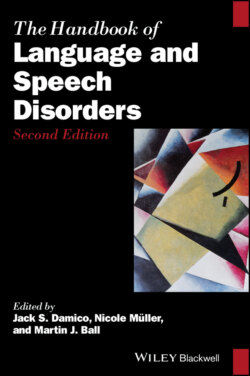Читать книгу The Handbook of Language and Speech Disorders - Группа авторов - Страница 51
3.3.7 Production of Prosody
ОглавлениеResearch on prosody production has shown that CI users, among other issues, have a higher F0 than controls (Poissant, Peters, & Robb, 2006; Szyfter et al., 1996), abnormal realization and usage of intonation (Chin, Bergeson, & Phan, 2012; Holt et al., 2017; Lee & Sim, 2020), a low speech rate (Evans & Deliyski, 2007; Uchanski & Geers, 2003), and a deviant voice quality (Baudonck et al., 2011; Monini, Banci, Barbara, Argiro, & Filipo, 1997; Ubrig et al., 2011). As an example of a study on linguistic prosody, in Lee and Sim (2020), final contours of imitated declarative and interrogative sentences were measured acoustically and evaluated for appropriateness by naïve raters. Children with CIs were found to distinguish the sentence types less clearly. Duration of implant usage was a significant predictor of these scores, showing that over time, CI users improve their prosodic control. In a comparable study (Peng, Tomblin, & Turner, 2008), such sentence‐type ratings were 74% correct when pronounced by CI users, and they achieved an appropriateness rating of 3.1 on a 5‐point scale, whereas with NH speakers the sentence type rating was 94% with an appropriateness of 4.5.
Research on emotional prosody production is sparser. A review by Jiam et al. (2017) points to studies on production of happy and sad vocal emotions by children and adults showing a lower accuracy in imitations (Nakata, Trehub, & Kanda, 2012) as well as in read sentences (Chatterjee et al., 2016). Comparable results have been reported by Bergeson and Chin (2008) and Wang, Trehub, Volkova, and van Lieshout (2013). Chatterjee et al. (2019), the preliminary results of which were presented in Chatterjee et al. (2016), longitudinally measured F0 mean and variability and mean intensity, duration and spectral centroid of happy and sad renderings of simple utterances in prelingually deafened children with CIs, postlingually deafened adults with CIs, and NH peers for both of those groups. The children with CIs showed the least amount of acoustic distinction between the emotions, mainly for F0‐related measures. The group of adult CI recipients were better able to contrast the emotions, which suggests, as the authors argue, that the acoustic input that they received prior to implantation supports normal vocal emotion expression. Moreover, the fact that they maintained the contrast after years of degraded (i.e., electric) hearing indicates that the sound representations that are developed and stored prior to implantation are very robust.
From the above discussion, a number of points are evident. Firstly, CI users have difficulties both with the perception and the production of linguistic and emotional prosody, especially when it comes to producing pitch‐related cues. Secondly, it must be reiterated that, despite these difficulties, in general, there is a large degree of individual variation in outcomes among CI users, with many showing speech production abilities that are commensurate with their NH peers. Finally, production skills depend, besides many other factors, upon demographic factors such as age at implantation, where older ages have a negative effect, and duration of device usage, where longer time periods have a positive effect.
The deviant speech of individuals with hearing loss show that in a general sense speech production quality depends on auditory feedback. A separate issue is to what extent the level of perception and production abilities are related to each other. Several studies show such a connection (Li, Lin, Yang, Chen, & Wu, 2018; Lyxell et al., 2009; O’Halpin, 2009; Peng, 2005), although see also Bergeson and Chin (2008), where the connection is less clear. In a review of a net selection of six studies performed between 1992 and 2012, Cysneiros, Leal, Lucena, and Muniz (2016) concluded that there was a positive relationship between expressive and receptive communication, but that there was a serious lack of quality research on this association. The complexities involved in this issue may stem from the multifactorial nature of influences on speech and language performance by CI users (Cosetti & Waltzman, 2012; Gillis, 2018; Lazard, Vincent, et al., 2012).
